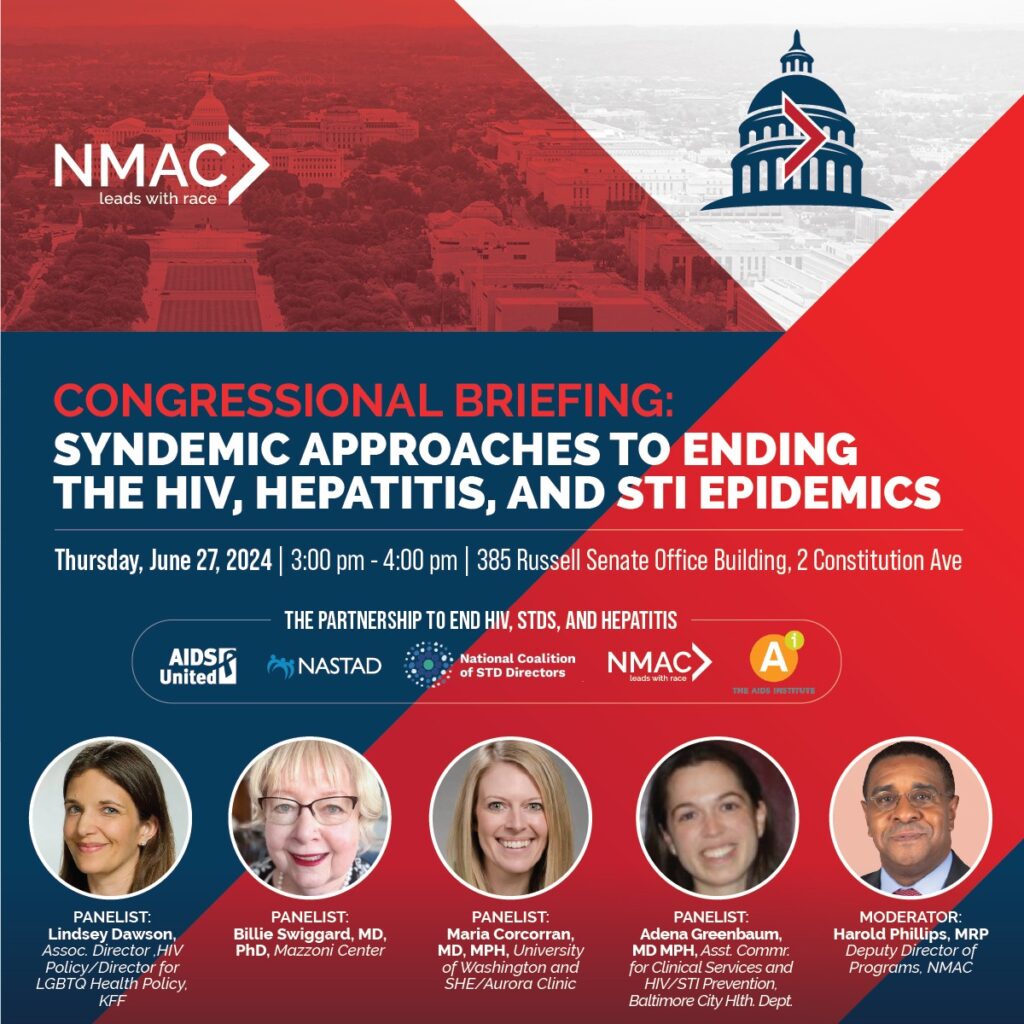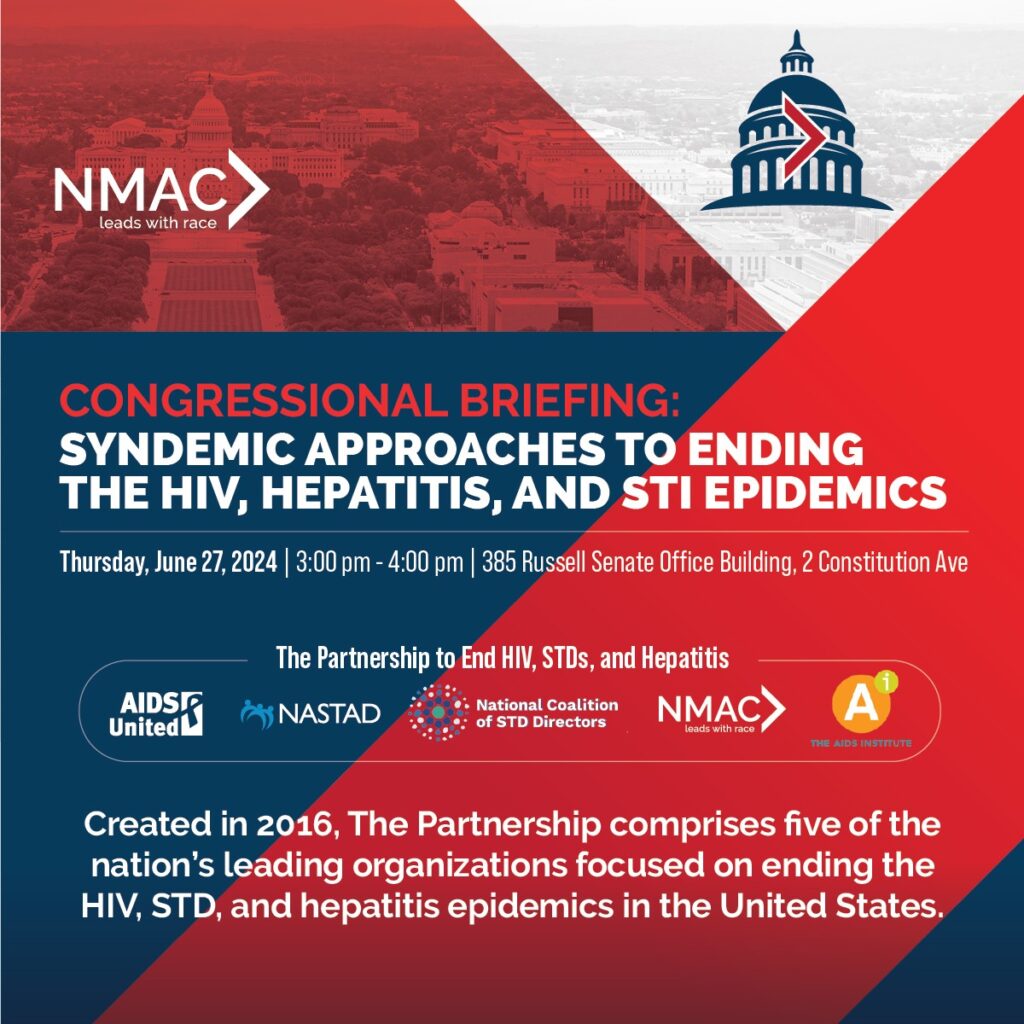Created in 2016, The Partnership comprises five of the nation’s leading organizations focused on ending the HIV, STD, and hepatitis epidemics in the United States.
Organizations and Executive Directors
Paul Kawata
Paul Kawata
Executive Director, NMAC
Congressional Briefing: Syndemic Approaches to Ending the HIV, Hepatitis, and STI Epidemics
Join an important briefing on the FY 2025 appropriations bills addressing federal funding for HIV, sexually transmitted infections (STIs), and hepatitis programs. During this briefing, panelists will discuss the importance of syndemic approaches and sustained and increased funding for these critical public health programs.
Refreshments will be served.
Date: June 27, 2024
Time: 3:00 PM – 4:00 PM
Location: 385 Russell Senate Office Building, 2 Constitution Avenue NE, Washington, DC 20002
RSVP: Email Zach Miller, Policy Manager, NMAC, ZMiller@NMAC.org
The session will cover:
- Syndemic approaches to our HIV, STI, and viral hepatitis epidemics
- Current funding levels and their impact
- Evidence-based needs, effective syndemic policies, and proposed budget allocations
- The implications of the appropriations on public health outcomes
Harold Phillips
Harold Phillips
Deputy Director of Programs, NMAC
Lindsey Dawson
Lindsey Dawson
Associate Director for HIV Policy/Director for LGBTQ Health Policy, Kaiser Family Foundation
Billie Swiggard
Billie Swiggard
MD, PhD, Mazzoni Center
Maria Corcorran
Maria Corcorran
MD, MPH, University of Washington and SHE/Aurora Clinic
*click to read bios
About The Partnership
Mission
To secure the necessary rights, resources, and services for those affected by the HIV, STD, and Hepatitis epidemics through sound policies and appropriations at the federal level.
Vision
A nation fully committed to ending the HIV, STD and Hepatitis epidemics, where all those affected by these diseases can easily access stigma-free prevention, care and treatment services.
How The Partnership works
The Partnership works with policymakers and others to preserve HIV, STD, and hepatitis legislative successes, promote necessary appropriation and funding levels, retain crucial aspects of existing health care coverage, including the Affordable Care Act (ACA) and Medicaid, and build upon the progress Federal programs have made on HIV, STD, and hepatitis prevention, treatment, care, and support over the last several decades.
The Partnership’s Advocacy Focus
HIV Prevention & Care
- Prevention: Despite tremendous progress with HIV prevention efforts, there are still an estimated 38,500 new infections each year. Continued funding for the CDC is needed to maintain recent gains and intensify prevention efforts in communities where HIV is the most prevalent. We must also expand access to pre-exposure prophylaxis (PrEP), a way for people who do not have HIV but who are at substantial risk of infection to prevent HIV infection by taking a pill every day. When taken consistently, PrEP has been shown to reduce the risk of HIV infection in people who are at high risk by up to 92%. PrEP is a powerful HIV prevention tool and can be combined with condoms and other prevention methods to provide even greater protection than when used alone.
- Care: The Ryan White HIV/AIDS Program provides a critical and comprehensive system of care that includes access to lifesaving medication to low income, uninsured, and underinsured individuals living with HIV in the U.S. through the AIDS Drug Assistance Program (ADAP), primary medical care, and essential support services for people living with HIV who are uninsured or underinsured, including premium assistance. As the program struggles to keep up with demand amid a changing and uncertain healthcare landscape, continued funding is critically important now and in the future to ensure that access to healthcare, medications, and other services for people with HIV are consistently maintained.
- Housing: The Housing Opportunities for Persons with AIDS (HOPWA) Program provides housing assistance and related supportive services for low-income people living with HIV and their families. Housing is the greatest unmet need for people living with HIV. Adequate funding for HOPWA is needed to ensure safe, affordable housing for low-income people living with HIV.
- SMAIF: Racial and ethnic minorities in the U.S. are disproportionately impacted by HIV. The Secretary’s Minority AIDS Initiative aims to improve the HIV-related health outcomes for racial and ethnic minorities and reduce HIV-related health disparities. The resources for MAI are designed to encourage capacity building, innovation, collaboration, and the integration of best practices.
STD Prevention
STD infections are at an all-time high in the U.S and these epidemics are worsening. A growing body of evidence shows that these epidemics are inextricably linked with the HIV and opioid epidemics. Sexually transmitted infections increase an individual’s risk of acquiring HIV, can result in severe birth defects, including infant death, and cause infertility and other negative health outcomes. Our nation must provide adequate and robust investments in STD prevention programs at the CDC. We must appropriately fund our public health infrastructure to address these growing epidemics.
Hepatitis
While there is a cure for HCV, there has been a 350% increase in the number of new cases between 2010 and 2016. And of the 3.5 million people living with HCV, only half are aware of their status. The elimination of hepatitis B and C in the United States is within our reach, but not without increased investments in comprehensive, national hepatitis prevention, screening, linkage to care, education and surveillance programs.
Opioid Epidemic
The current opioid epidemic is a public health crisis not only because of its ties to injection drug use and overdoses, but also because of its role in increases in infectious diseases like HIV, STDs, and hepatitis. Increased funding will enable the CDC and its grantees to better tackle these recent opioid-related spikes in infections, help jurisdictions scale up prevention efforts, including syringe service programs, increase infectious disease testing and linkage to care and treatment, and fund comprehensive viral hepatitis surveillance systems.




